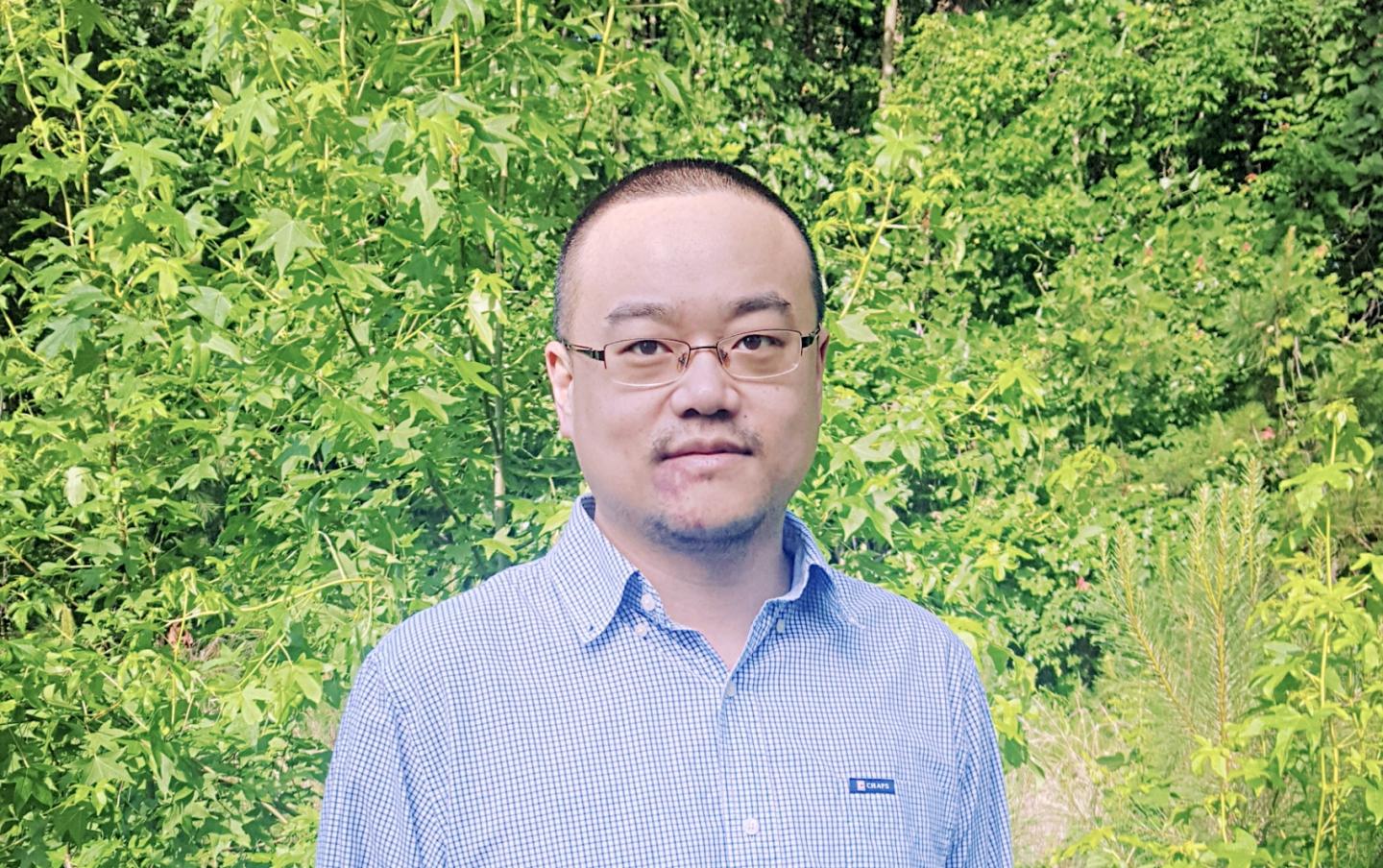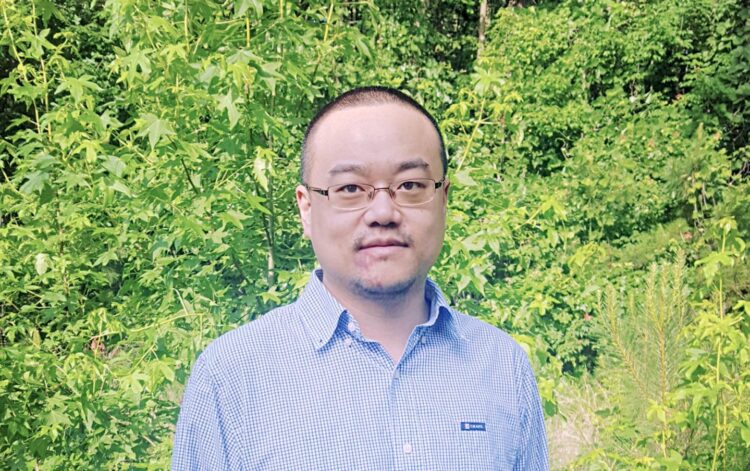Postdoctoral Prize winner Wenliang “Bill” Li won the 2020 JSA Postdoctoral Prize to run experiments that will examine proton structure from a lesser-studied perspective

Credit: Wenliang
To help people understand the research he conducts at the Department of Energy’s Thomas Jefferson National Accelerator Facility, Wenliang “Bill” Li likens it to studying the dark side of the moon. Now, the research he is undertaking from this unusual perspective has earned him the 2020 Jefferson Science Associates Postdoctoral Prize.
A postdoctoral researcher at William & Mary, Li is studying proton structure just like many people who conduct their nuclear physics research at Jefferson Lab. But he’s studying a new aspect of it: the backward perspective.
Usually, nuclear physicists at Jefferson Lab measure proton structure from the forward perspective. They shoot electrons at a proton target, which forms a spray of particles that fly forward into detectors, telling them more about proton structure. But Li is looking at the particles created in that same interaction that go backward instead of forward. Using Jefferson Lab’s 12 GeV electron beam to blast a proton target, he’ll study what’s flying backward after the electron hits the proton to learn more about proton structure.
“It’s not that intuitive. It’s adding a new perspective to the overall picture,” he said. “If we don’t understand what I’m measuring now, then we cannot declare the victory of knowing the true structure of a proton.”
Previously, many physicists assumed there was little worth measuring in the backward perspective.
“The idea that there are measurable, important particles flying backward is new,” Li explained.
He said that’s why he compares his research to the dark side of the moon to explain it.
“We look at the moon all the time, but we only look at the side always facing us,” he said. “Looking at the backward angle of the electron-proton interaction is almost like probing the side of the proton that you cannot see from the forward angle.”
Previously, all of the equipment at Jefferson Lab, including the detectors and targets, was set up to only examine proton structure from the forward perspective. Li had to figure out how to use the existing detectors and targets to capture the interaction from the backward perspective. He has already helped conduct experiments measuring the so-called backward-angle observables, but these interactions are still not fully understood.
The Jefferson Lab User Organization Board of Directors has awarded the JSA Postdoctoral Prize since 2008. The group represents the scientists who come to Jefferson Lab to conduct research with its unique facilities. The board judges each applicant on their record of accomplishment in physics, proposed use of the research grant, and the likelihood of further accomplishments in the Jefferson Lab research fields.
“While all submissions were of outstanding quality, Wenliang Li’s proposal was selected as the winning entry based on the research impact, the scientific importance of the research, and the ability of the candidate to carry out the project, taking into account the candidate’s CV, research statement, and support letters,” said Will Brooks, JLUO BOD chairperson and founding experimental group leader at Universidad Técnica Federico Santa María, Valparaíso, Chile, where he is also a professor. “Wenliang gave a compelling invited talk related to his project at the recent JLUO Annual Meeting, demonstrating that it will have an important impact on the future of Jefferson Lab for our international community of theorists and experimentalists. Young scientists like Wenliang and his peers are crucially important for the vigor and excellence of the scientific future of our field, and it is of utmost importance for our community to support them in every possible way.”
The grant is funded by the Jefferson Science Associates Initiatives Fund program, which JSA provides to support programs, initiatives and activities that further the scientific outreach, and promote the science, education and technology missions of Jefferson Lab and benefit the laboratory’s user community. The competition was coordinated by Edward Brash, a professor at Christopher Newport University and the JLUO BOD chair-elect, who formed an external committee of reviewers to assess the submitted projects.
“It was a big encouragement receiving this grant,” Li said.
Li is currently in his first postdoctoral position. He graduated in 2017 with a doctorate in experimental nuclear physics from the University in Regina in Canada. He first began working with Jefferson Lab 10 years ago as a master’s student. Back then, he helped his supervisor build a detector for the 12 GeV Upgrade for Hall C.
“Now, I’ll be able to use the detectors I helped build,” he said.
For his project, titled “Studying the Backward-angle Physics in JLab 12 GeV and EIC,” Li initially planned to use the $10,000 prize money to bring in a collaborator: Kirill Semenov-Tian-Shansky from the National Research Centre «Kurchatov Institute» – Petersburg Nuclear Physics Institute in Gatchina, Russia.
While Li is an experimental physicist, Semenov-Tian-Shansky is a theoretical physicist. Semenov-Tian-Shansky and his colleagues, Bernard Pire from École Polytechnique and Lech Szymanowski from the Soltan Institute for Nuclear Studies, have published pioneering work in backward-angle physics.
“He is really the leading expert in this field,” Li said.
The plan was for Semenov-Tian-Shansky to come to Virginia for one month, so that the pair could work together in person, but that’s no longer an option due to recent global events. Now, Li isn’t sure when, or even if, Semenov-Tian-Shansky can come to the U.S., so they have to work long distance.
“I was really delighted to hear about Bill’s award,” Semenov-Tian-Shansky said. “He is an extremely bright, young experimentalist. I must say that he inspired me much with his enthusiasm.”
Li will conduct experiments to measure the backward angle interactions, and Semenov-Tian-Shansky will perform calculations to relate it to proton structure. As they progress, Semenov-Tian-Shansky will tell Li what measurements he needs to do to develop a better mathematical picture of what’s going on in the backward perspective.
“Much still has to be done to single out and interpret properly this new kind of structural information,” Semenov-Tian-Shansky said. “Fortunately for us, Jefferson Lab’s experimental setup includes detectors with fantastic capabilities, and even more important is that these detectors are handled by the outstanding experimental team. I think this is the beginning of another beautiful collaboration.”
Together, Li and Semenov-Tian-Shansky will also develop a strategy to transition experiments on backward-angle observables from the 12 GeV research program at Jefferson Lab to the proposed Electron-Ion Collider (EIC), which will be built at DOE’s Brookhaven National Laboratory in New York in collaboration with Jefferson Lab.
“We feel urgency to get our work done, because the EIC is also getting started,” Li said. “The timing is actually driving us to finish this work soon. We’re pumped!”
Contact: Kandice Carter, Jefferson Lab Communications Office, 757-269-7263, [email protected]
###
Jefferson Science Associates, LLC, a joint venture of the Southeastern Universities Research Association, Inc. and PAE, manages and operates the Thomas Jefferson National Accelerator Facility, or Jefferson Lab, for the U.S. Department of Energy’s Office of Science.
DOE’s Office of Science is the single largest supporter of basic research in the physical sciences in the United States and is working to address some of the most pressing challenges of our time. For more information, visit https:/
Media Contact
Kandice Carter
[email protected]
Original Source
https:/





